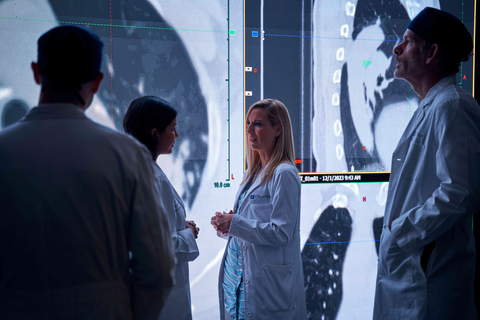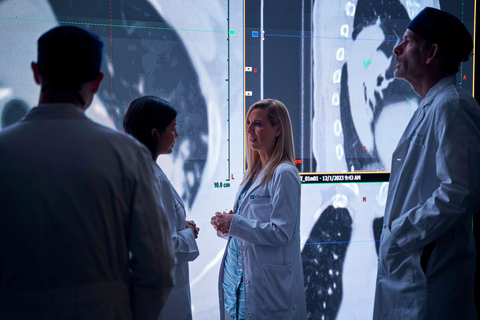LOS ANGELES--(BUSINESS WIRE)--City of Hope®, one of the largest and most advanced cancer research and treatment organizations in the U.S. and ranked among the nation’s top 5 cancer centers by U.S. News & World Report, is part of today’s press conference program at the American Society for Radiation Oncology (ASTRO) Annual Meeting, where a renowned City of Hope radiation oncologist will present phase 3 clinical trial data showing that people with limited-stage small cell lung cancer may benefit from adding immunotherapy to chemoradiation, but not if both treatments are given at the same time. The results suggest that the timing of when immunotherapy is given plays a key role in its ability to extend survival.
“The introduction of immunotherapy marked the first significant breakthrough in treating small cell lung cancer treatment in decades. Now, we see that if you give immunotherapy concurrently with chemoradiation, it does not yield the same survival benefit as it does when we add it after standard treatment,” said lead author Kristin Higgins, M.D., a radiation oncologist, clinical professor and chief clinical officer at City of Hope Cancer Center Atlanta.
Dr. Higgins is presenting the late-breaking abstract at a 10 a.m. ET press conference today in room 103A of the Walter E. Washington Convention Center in Washington, D.C.; the scientific plenary will take place at 2:10 p.m. ET in Ballroom A/B/C.
ASTRO is the world’s largest radiation oncology society, with more than 10,000 members. Radiation therapy contributes to 40% of global cancer cures, and more than 1 million Americans receive radiation treatments for cancer each year.
Lung cancer is the leading cause of cancer deaths in the U.S. An aggressive form of the disease is small cell lung cancer, which accounts for 10-15% of all lung cancers. Standard treatment for patients with limited-stage disease that has not spread outside the chest and is potentially curable includes concurrent radiation therapy and chemotherapy. While treatments can be effective initially, the cancer often recurs and options for additional treatment have historically been limited.
Dr. Higgins and her colleagues randomized 544 patients at centers across the U.S. (n=500) and Japan (n=44) to receive standard chemoradiation with or without atezolizumab immunotherapy. All patients received radiation therapy either twice daily or once daily as well as four cycles of concurrent chemotherapy. For patients on the experimental arm, atezolizumab was also given every three weeks beginning at the start of radiation, for a maximum of one year.
Contrary to expectations, concurrent treatment with atezolizumab and chemoradiation did not improve survival rates compared to standard care. The lack of survival benefit when giving immunotherapy together with chemoradiation, rather than after radiation is completed, indicates that the activity of this type of immunotherapy is reduced when given simultaneously with thoracic radiation, likely due the inherent immunosuppressive effects of radiation, Dr. Higgins explained.
“We know that radiation suppresses the immune system to a certain degree in the immediate sense, and immunotherapy relies on the immune system to be effective,” she said. “Adding these drugs after you give radiation can make the immunotherapy more potent, but you have to allow the immune system time to recover to really see the two work well together.”
There was a benefit to giving radiation twice daily over giving it once daily, regardless of study arm. In both groups, patients treated twice daily lived longer on average; median overall survival for those treated twice daily was 35.4 months, compared to 28.3 months for people treated once per day.
“Sometimes, if you give too much therapy at the same time, it actually yields worse outcomes. And this trial demonstrated that. But at the same time, we did see that changing the way you give radiation can help,” Dr. Higgins said, noting that City of Hope continues to be at the forefront of a powerful form of immunotherapy known as chimeric antigen receptor (CAR) T cell therapy. City of Hope researchers are among the scientists working to develop and test new lung cancer immunotherapy treatments.
Other world-renowned City of Hope physicians and researchers also will present new data and offer expert perspectives on leading-edge cancer research and treatments in development.
Is biology-guided radiotherapy an option for people with prostate cancer?
Presentation time and location: Monday, Sept. 30, from 3:50 to 4 p.m. ET in Room 145
City of Hope was the first in Southern California and among the first in the nation to adopt a type of biology-guided radiotherapy called SCINTIX therapy that later in 2023 was cleared by the U.S. Food and Drug Administration. This study, led by Chunhui Han, Ph.D., City of Hope clinical professor of radiation oncology, included prostate cancer patients and resulted in the development of a comprehensive set of screening criteria to identify people who would benefit from this leading-edge, personalized radiation oncology treatment. City of Hope aims to develop efficient protocols so that other institutions one day can also implement the SCINTIX therapy on the RefleXion X1.
Phase 2 trial with leukemia patients could lead to radiotherapy that attempts to bypass harm to organs
Presentation time and location: Monday, Sept. 30, from 5:10 to 5:20 p.m. ET in Room 144
In a phase 2 trial noted as the largest prospective study using total marrow and lymphoid irradiation (TMLI), Jeffrey Wong, M.D., City of Hope professor of radiation oncology, Anthony Stein, M.D., and colleagues treated 74 patients with either acute myeloid leukemia (AML) or acute lymphoblastic leukemia (ALL) with TMLI, which delivers targeted radiation to bone marrow while reducing negative impact to organs. The team developed a regimen that could be an effective hematopoietic cell transplant option for AML and ALL patients with recurrent cancer or disease that has become resistant to treatment. The regimen is currently under evaluation as a potential replacement for standard total body irradiation conditioning in patients with AML who are in complete remission. City of Hope’s bone marrow and blood stem cell transplant program is the largest in the country; its doctors have performed nearly 20,000 transplants to date.
Study evaluating effectiveness of pre-transplant radiotherapy that limits toxicity to organs
Presentation time and location: Tuesday, Oct. 1, from 1:25 to 1:35 p.m. ET in Room 144
Colton Ladbury, M.D., City of Hope assistant professor of radiation oncology, led the largest study to date reporting long-term toxicities resulting from total marrow irradiation (TMI) and total marrow and lymphoid irradiation (TMLI), both of which are used to prepare patients for a stem cell transplant. Some 302 patients with multiple myeloma or acute leukemia were followed for up to eight years with median follow-up of 6.3 years in living patients. They found that TMI/TMLI is associated with lower rates of pulmonary toxicity, renal toxicity and hypothyroidism compared with historical cohorts treated with conventional total body irradiation.
Dr. Ladbury is one of 12 residents in the world to receive an ASTRO recognition award for his quick pitch oral. The award is designed to highlight excellence among peers at the largest annual meeting of radiation oncologists from around the globe.
A potentially better way to deliver radiotherapy and chemotherapy to people with lung cancer
Presentation time and location: Tuesday, Oct. 1, from 1:25 to 1:35 p.m. ET in Room 147
In an early-phase trial, researchers led by Percy Lee, M.D., City of Hope professor of radiation oncology, found that it is safe and effective to treat patients with locally advanced, inoperable non-small cell lung cancer using chemoradiation via a dose-escalated adaptive stereotactic ablative radiotherapy boost in 15 sessions of radiation instead of the standard 30 sessions as they also receive chemotherapy.
Using AI to evaluate immune system response
Presentation time and location: Tuesday, Oct. 1, from 1:25 to 1:35 p.m. ET in Room 152
Immuno-positron emission tomography (ImmunoPET) allows for spatial evaluation of white blood cell distributions. William Tyler Watkins, Ph.D., physicist and City of Hope associate clinical professor, led a research team that leveraged artificial intelligence (AI) to segment the human body and evaluate CD8+ T cell concentrations before and after radiation therapy. The model was validated using data from five patients in an ongoing clinical trial and identifies varying patient-specific immune system response following radiation treatment.
Novel theranostic PET imaging agent for patients with advanced rectal cancer
Presentation time and location: Tuesday, Oct. 1, from 5:15 to 5:25 p.m. ET in Room 152
In an ongoing pilot study, Jeffrey Wong, M.D., City of Hope professor of radiation oncology, and colleagues found that a radioactive molecule attached to a monoclonal antibody (Cu-64-Anti-CEA M5A) shows promise as a theranostic — therapy plus diagnostic — tool that allows experts to identify disease sites in patients with rectal cancer. It also shows promise as a way to assess response to chemotherapy and radiotherapy received before cancer treatment, such as surgery. More research is needed to fully understand this therapeutic’s disease targeting and efficacy capabilities.
The below oral presentations have already been presented.
A promising treatment regimen for prostate cancer patients
Presentation time and location: Sunday, Sept. 29, from 8:30 to 8:40 a.m. ET in Room 207B
Early data from an ongoing phase 2 trial led by Savita Dandapani, M.D., Ph.D., City of Hope associate professor of radiation oncology, suggests that a promising treatment regimen for patients with metastatic castration-sensitive prostate cancer is radium 223 dichloride (Ra-223) combined with stereotactic body radiation therapy delivered to tumors that have spread to bone. The treatment plan should include 36 weeks of androgen deprivation therapy combined with the radiation. This is an early trial to show that the use of systemic radiation (radiopharmaceuticals) with stereotactic body radiation treatment may help prevent progression of micrometastases.
A new way to determine the strength of phase 3 cancer clinical trials
Presentation time and location: Sunday, Sept. 29, from 5:05 to 5:15 p.m. ET in Room 207B
A team of researchers led by Yufei Liu, M.D., Ph.D., City of Hope assistant clinical professor of radiation oncology, developed a benchmark to assess the strength of phase 3 clinical trials. They evaluated a database of 332 phase 3 oncology trials and found that targeted therapy trials, trials with progression-free survival as a final endpoint and positive trials tend to have the most robust, reproducible data. More work needs to be done to validate the developed benchmark, which could then be leveraged to design better clinical trials.
About City of Hope
City of Hope's mission is to make hope a reality for all touched by cancer and diabetes. Founded in 1913, City of Hope has grown into one of the largest and most advanced cancer research and treatment organizations in the U.S., and one of the leading research centers for diabetes and other life-threatening illnesses. City of Hope research has been the basis for numerous breakthrough cancer medicines, as well as human synthetic insulin and monoclonal antibodies. With an independent, National Cancer Institute-designated comprehensive cancer center that is ranked top 5 in the nation for cancer care by U.S. News & World Report at its core, City of Hope’s uniquely integrated model spans cancer care, research and development, academics and training, and a broad philanthropy program that powers its work. City of Hope’s growing national system includes its Los Angeles campus, a network of clinical care locations across Southern California, a new cancer center in Orange County, California, and cancer treatment centers and outpatient facilities in the Atlanta, Chicago and Phoenix areas. City of Hope’s affiliated group of organizations includes Translational Genomics Research Institute and AccessHopeTM. For more information about City of Hope, follow us on Facebook, X, YouTube, Instagram and LinkedIn.




